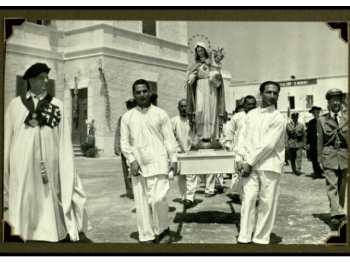The Order’s solidarity for the prisoners of Ventotene

“One of the criminals who hung there hurled insults at him: ‘Aren’t you the Messiah? Save yourself and us!’ But the other criminal rebuked him. “Don’t you fear God,” he said, “since you are under the same sentence? We are punished justly, for we are getting what our deeds deserve. But this man has done nothing wrong.” Then he said, “Jesus, remember me when you come into your kingdom.” Jesus answered him, “Truly I tell you, today you will be with me in paradise.” (Luke 23:39-43)
We are men and women capable of immense good, yet also capable of sin. Nevertheless, Jesus clearly teaches us that we are not defined by what we do, but by who we are: beloved children of God, who always comes back to seek us and, until the very last moment, offers the possibility to choose Him and be with Him. Just like the “thieves” crucified beside Jesus, today many prisoners are serving their sentences, and offering them a chance for comfort is an important calling that, as Knights and Dames of the Order of the Holy Sepulchre over the years, we have made our own and, particularly during this Jubilee, wish to remember.
On June 18, 1953, during the Conference of Regional Delegates of the Chaplains of the Prevention and Penal Institutions, His Holiness Pope Pius XII received a group of prisoners in an audience. At the encounter, he blessed a Statue of the Madonna that the Equestrian Order of the Holy Sepulchre of Jerusalem had wished to donate to the Ventotene prison, on the small island of Santo Stefano. The statue of the “Madonna of Consolation” arrived in Gaeta on August 7, and from there, as reported by L'Osservatore Romano, it was placed on a throne that the prisoners had wanted to prepare for her. The statue then passed through the city of Gaeta before being embarked on August 8 aboard the ship Pellicano (in English: pelican), a name that evokes the symbol of the Eucharist, a gift of consolation and grace.
For the Order of the Holy Sepulchre, which wished to make this gift to the prisoners of the Santo Stefano penitentiary, Dr. Mario Mochi, a dignitary of the Order, and two Knights from Naples were present. In addition to the prisoners who welcomed the Madonna onto the island, there were also the boats of Ventotene’s inhabitants, and on the cliff adjacent to the prison, three large signs with clearly visible writings: “This is a place of pain...”, “...a place of atonement...”, “...but above all, a place of redemption...”.
In the Vatican newspaper, it was recounted thus in an article dated August 10-11, 1953, “Along the arcades, at the windows, at the doors, everywhere, small flags and garlands, and banners exclaiming ‘Long live Mary,’” The article also spoke of how many prisoners had wept with emotion. Taking turns, some of the prisoners had the joy of carrying the statue of Mary on their shoulders from the cliff to the top of the rock on the small island of Santo Stefano. From there, Mary – despite the state of neglect of the place after the prison's closure in 1965 – still protects that corner of the world that has witnessed so much suffering, but also repentance and the beginning of new lives.
In the following days, letters from some prisoners were shared, recounting the event. “With the statue of the Madonna of Consolation,” one of them wrote, “Holy symbol of all mothers and of our suffering ones in particular, you have wished to bring us the most tangible sign of human solidarity, so that, in addition to being a source of comfort, it may also be an encouragement and a guide in the harsh journey of life.”
In this Jubilee Year, which will conclude the calendar of major events with the Jubilee of Prisoners, we wish to remember the importance of being close to those who are suffering the most. Among the norms for granting indulgences during the Holy Year, there are also works of mercy. As we read in the document published by the Apostolic Penitentiary, “During the Holy Year, we are called to be tangible signs of hope for those of our brothers and sisters who experience hardships of any kind.” (Spes non confundit, 10). Therefore, the Indulgence is also associated with works of mercy and penance, through which the conversion undertaken is witnessed. The faithful, following Christ’s example and mandate, are encouraged to perform works of charity or mercy more frequently, primarily in service of those brothers and sisters burdened by various needs, including prisoners.
Elena Dini
We thank Dr. Rosa Immacolata Cirone, former head of the office of the Pistoia Detention Center, for sharing this story with us and sending historical material on the subject.
(March 2025)



